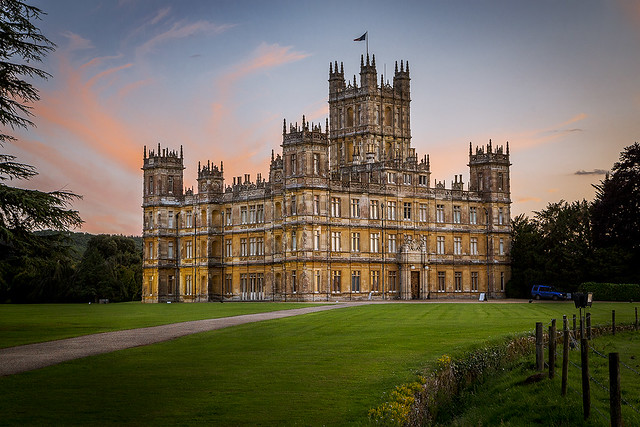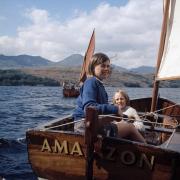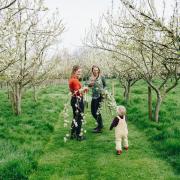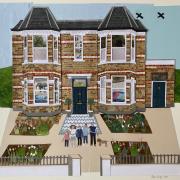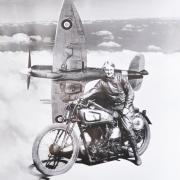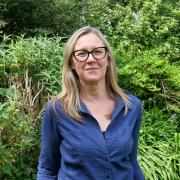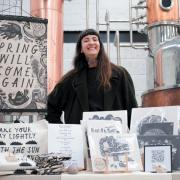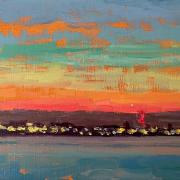Everyday life at Highclere Castle isn’t all lights, camera, action. Viv Micklefield meets the real Downton mistress and asks, what keeps her grounded?
This article was originally published in 2018
“When I was asked by my now husband to come down to Highclere, before we were married, you know that the best things to bring are warm clothes and a hot water bottle!” says Lady Carnarvon, with the matter-of-factness of someone all too familiar with staying in historic country houses, where leaking roofs and faulty plumbing come with the territory. However, only later, when she and George ‘Geordie’ Herbert, 8th Earl of Carnarvon, became custodians of the famous Hampshire estate in 2001 did reality hit.
Not lived-in since the Earl’s grandfather passed away in the 1980s, Highclere was the victim of what the former accountant in her calls, “about a hundred years of investment deficit”. Of its 300 rooms, only a smattering on the ground and first floors remained usable. So, fixing up the pseudo-Jacobean pile, designed by Houses of Parliament architect Sir Charles Barry, meant starting with the part in most dire condition. The main roof!
“I thought, if I’m going to work hard for a piece of heritage, something to be passed on to future generations to enjoy, then I want to share it as a home,” she recalls, adding, “It’s far bigger than putting your own stamp on it. More a case of listening to and working with people; I’ve learnt an enormous amount from the contractors. And, you can’t rush things. It takes time, as the house almost tells you what needs to happen next.”
There’s no denying, however, that achieving a significant dent in the estimated £12 million repair bill is thanks, in no small part, to the cash injection following the global success of TV’s Downton Abbey. With all six series of the Crawley family saga having been filmed on location at Highclere, visitor numbers almost doubled overnight, enabling turrets and stonework to be restored. Whilst internally, aided by English Heritage and girlfriends with a penchant for interior décor, progress is measured by the bathrooms renovated and orders of up to 140 lampshades at a time.
“It’s been quite a big endeavour,” says the real mistress of Downton with genuine understatement, “because I really wanted to give the house back its heart.”
Having been born in London in 1963, it’s a notion that, perhaps, stems from her own upbringing.
“I’m one of six girls and there was always lots of cooking going on at home; I think food is at the heart of things. In some ways, I’ve written my latest book ‘At Home at Highclere: Entertaining at the real Downton Abbey’ to share how I grew up and some of the food that I grew up with.”
Having researched some of the eminent houseguests Highclere has welcomed through the centuries – Royalty, statesmen and explorers including Egyptologist Howard Carter all figure, the book chronicles four weekends between 1866 and 1936 when some of the country’s great and good were here; the pages painting a picture of the art of entertaining past and present.
It’s certainly no coincidence that three of Lady Carnarvon’s seven dogs make the front cover. “There’s nothing better to come back home to than a dog,” she says fondly. “I’ve got Labradors and spaniels which are so gentle; they make my life whole.”
Continuing: “Initially, there were no private rooms where Geordie and I could just sit. So I found an unused room at the back of the house and that’s where I first started to create what’s now become a warm, and indeed today, rather messy family room. It’s definitely ‘our room’ as you usually have to move piles of books off the furniture and on to the floor.”
It’s here, apparently, that much of her writing is done.

“Writing with classical music playing settles my head in a different space and I particularly enjoy listening to Mozart and John Rutter. My mother loved Handel, so I love his music too because it reminds me of family drives down to Cornwall for our holidays. And I have other childhood favourites, like Bach’s ‘Jesu, Joy of Man’s Desiring’; I find such music reassuring and utterly sublime.”
When not researching her next book – Highclere’s 300-year-old archives are manna from heaven for a self-confessed lover of history, what I wonder does Lady Carnarvon read in her spare time? Is it the World War One poetry over which the then Fiona Aitken and the future Earl reputedly bonded, on being introduced?
“I’ve just finished Robert Harris’s latest book ‘Munich’ which I’ve thoroughly enjoyed. And I do read a few airport books as well,” she laughs. “I like Andrew Roberts’s military histories, as well as learning about our Neolithic ancestors. And I do read a lot of poetry; George Herbert is one of my favourites.
“Also, I’ve read quite a lot of books on the visible landscape and this particular area.
“My husband and I both love gardening and the monks who once lived here had orchards and herbs, so the new herb garden looks back to that time, although it’s more accessible to visitors being nearer to the house.
“Oaks from Highclere were used to build Winchester College. And at the harvest festival in October, we sing ‘The Hymn to the Hampshire Countryside’, which is good fun, as I try to bring animals and tractors into the churchyard. It’s a way to remind us all about the beautiful chalk streams and hills.”
Downton Abbey may now be off air but scriptwriter Julian Fellowes remains a long-standing friend. And the debt owed to the historical drama looms as large as the house that dominates life on the Highclere estate, which the Carnarvons and their teenage son Edward share with an extended family of up to 200 staff.
“How could I not be a fan of the show?” Lady Carnarvon concedes. “I almost enjoyed the ‘downstairs’ bits more than the ‘upstairs’. They were here on set from February through to July each year but we managed to keep Highclere’s events such as the Game Fair going, although it took some ducking and diving!”
Having seen the plot’s twists and turns, is the Downton era one she’d have wanted to live through herself?
“I think so, but it’s now knowing that they were going to come out of the First World War and then plunge into the Second. My own books, about Highclere’s Countesses Almina and Catherine, have looked at both those periods and I find World War One so tragic and deeply pointless. It’s intensely difficult to write about.
“You do however sometimes need to look at the past to show the way forward.”
There are, she reveals, plans to honour and raise money “for those who serve and those who save, as well as the victims of war” at a special Garden Party this summer. Before going on to explain: “These might be former soldiers who become homeless or struggle with their mental health. And also the Syrian refugees.
“I write my books and blog as Lady Carnarvon. It’s not about being political. I’m just trying to make observations about this extraordinary place in which I’m lucky enough to live.
“The conversations my blog sparks reaches well beyond these shores. Often during the evening, I’ll switch on my computer, sit down with a cup of ginger tea and thoroughly enjoy replying to the comments.”
Sample the life
Lady Carnarvon’s latest blog can be found at www.ladycarnarvon.com. To find out more about Highclere’s history, public opening times and upcoming events, visit www.highclerecastle.co.uk.
More…
• 10 castles and forts to visit in Hampshire - The castles and forts around the county make for a fascinating ghost hunt by night, and a fun family trip by day says Claire Pitcher



